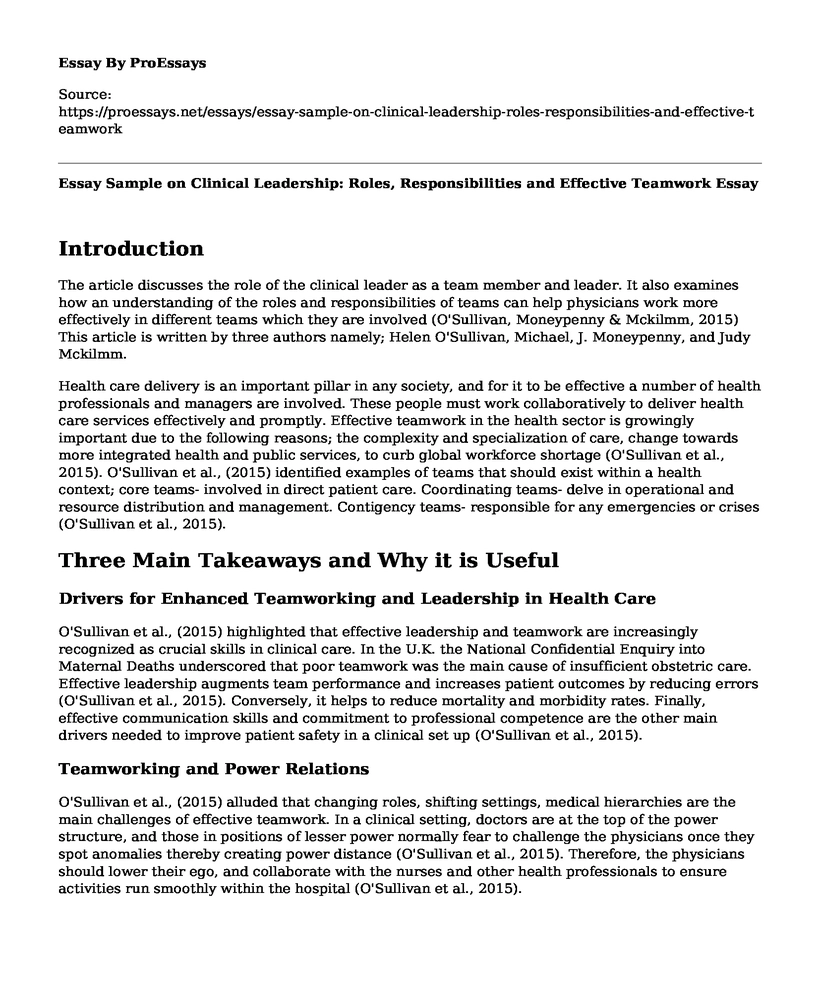Introduction
The article discusses the role of the clinical leader as a team member and leader. It also examines how an understanding of the roles and responsibilities of teams can help physicians work more effectively in different teams which they are involved (O'Sullivan, Moneypenny & Mckilmm, 2015) This article is written by three authors namely; Helen O'Sullivan, Michael, J. Moneypenny, and Judy Mckilmm.
Health care delivery is an important pillar in any society, and for it to be effective a number of health professionals and managers are involved. These people must work collaboratively to deliver health care services effectively and promptly. Effective teamwork in the health sector is growingly important due to the following reasons; the complexity and specialization of care, change towards more integrated health and public services, to curb global workforce shortage (O'Sullivan et al., 2015). O'Sullivan et al., (2015) identified examples of teams that should exist within a health context; core teams- involved in direct patient care. Coordinating teams- delve in operational and resource distribution and management. Contigency teams- responsible for any emergencies or crises (O'Sullivan et al., 2015).
Three Main Takeaways and Why it is Useful
Drivers for Enhanced Teamworking and Leadership in Health Care
O'Sullivan et al., (2015) highlighted that effective leadership and teamwork are increasingly recognized as crucial skills in clinical care. In the U.K. the National Confidential Enquiry into Maternal Deaths underscored that poor teamwork was the main cause of insufficient obstetric care. Effective leadership augments team performance and increases patient outcomes by reducing errors (O'Sullivan et al., 2015). Conversely, it helps to reduce mortality and morbidity rates. Finally, effective communication skills and commitment to professional competence are the other main drivers needed to improve patient safety in a clinical set up (O'Sullivan et al., 2015).
Teamworking and Power Relations
O'Sullivan et al., (2015) alluded that changing roles, shifting settings, medical hierarchies are the main challenges of effective teamwork. In a clinical setting, doctors are at the top of the power structure, and those in positions of lesser power normally fear to challenge the physicians once they spot anomalies thereby creating power distance (O'Sullivan et al., 2015). Therefore, the physicians should lower their ego, and collaborate with the nurses and other health professionals to ensure activities run smoothly within the hospital (O'Sullivan et al., 2015).
Leading and Building a Health Care Team
O'Sullivan et al., (2015) suggested that the critical areas for consideration when leading or developing a health-care team include; communication, decision-making, patient safety, and conflict resolution. On communication, physicians must seek effective methods of communication to appropriately manage their teams (O'Sullivan et al., 2015). Regular meetings that establish a context that welcomes the autonomous expression of a team member's opinions are mainly significant (O'Sullivan et al., 2015). The device that can help team members communicate includes SBAR (a situation, background, assessment and recommendation) (O'Sullivan et al., 2015).
In a group setting, a clinical leader should be cognizant of the tendency for "group thinks" and allow members to contribute their thoughts, afterwards they cohesively discuss the validity or basis of the thoughts (O'Sullivan et al., 2015). It will enhance inclusivity and no one will feel left out. At the center of the team's goals should be improving their patient-centered approach to health care. The clinical leader should have a framework to solve any impending conflicts that may seem to weaken the strong resolve within the group (O'Sullivan et al., 2015). The framework should revolve around creating group-trust, and mutual respect on divergent opinions.
Conclusion
In conclusion, leading and working in a team set up is an essential skill that health professionals need to have. The three highlighted points are useful as they show the importance of having teams with a clear structure based on patient centered goals, conflict resolution mechanisms, and effective communication modals.
References
O'Sullivan, H., Moneypenny, M. J., & McKimm, J. (2015). Leading and working in teams. British Journal of Hospital Medicine, 76(5), 264-269. Retrieved from: file:///C:/Users/User/Downloads/BJHM_Moneypenny_OSullivan_McKimm_2015_leadingandworkinginteams%20(1).pdf
Cite this page
Essay Sample on Clinical Leadership: Roles, Responsibilities and Effective Teamwork. (2023, Mar 25). Retrieved from https://proessays.net/essays/essay-sample-on-clinical-leadership-roles-responsibilities-and-effective-teamwork
If you are the original author of this essay and no longer wish to have it published on the ProEssays website, please click below to request its removal:
- Small Business Growth and Development Essay
- Haidilao Holdings Analysis Paper Example
- Essay Sample on Netflix Strategic Plan
- The Definition and Foundation of Leadership Essay Example
- Leadership: Born or Learned? A Leader's Essential Qualities - Essay Sample
- Paper Example on Global Strategies for Medifast Ado: Key Considerations
- Understanding Production - Report Sample







